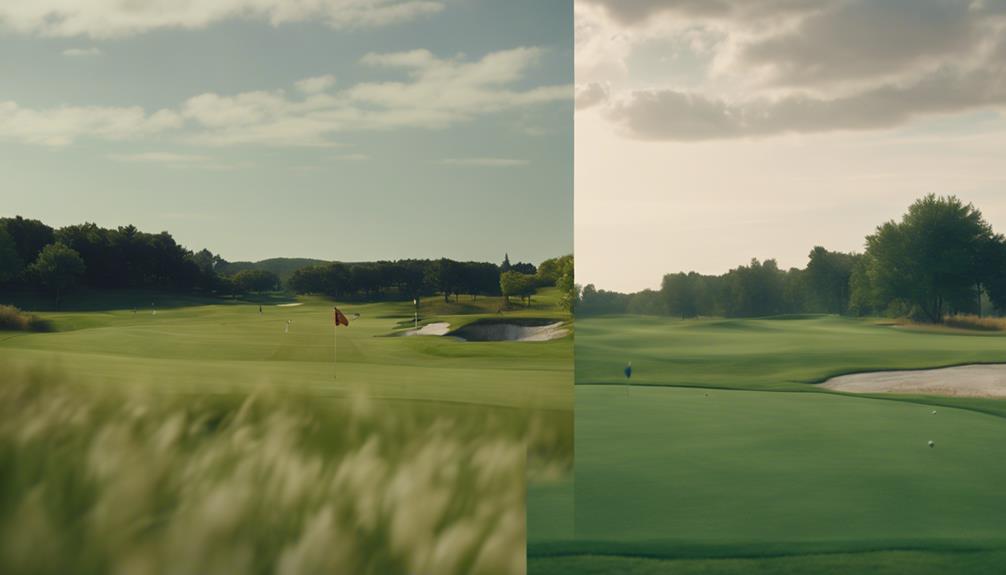- 7 Top Flite Golf Clubs XL for Improved Performance - September 28, 2024
- Top Flite Golf Clubs: Top 5 Reasons to Choose Them - September 28, 2024
- Top 3 Golf Club Fitters for a Perfect Swing - September 28, 2024
As you step onto a golf course in Europe, you'll encounter a distinct set of challenges and nuances that differ significantly from those you'd experience in the USA. European courses feature rugged, natural terrain with treacherous pot bunkers, dense rough, and quick, contoured greens that demand precise shot-making skills. In contrast, American courses tend to be more manicured, with tree-lined fairways, water hazards, and smooth playing surfaces. The way you play and think about the game will need to adapt to these differences, and that's just the beginning – there are more surprises in store as you explore the 7 key differences between golf in Europe and the USA.
Key Takeaways
- European golf courses feature rugged, natural terrain with deep pot bunkers, undulating fairways, and dense rough, demanding precise shot-making skills.
- In contrast, US courses often have tree-lined fairways, water hazards, and manicured landscapes, promoting controlled play and a focus on amenities.
- The handicap systems differ, with the US considering all rounds played and being potential-based, while the UK system only includes tournament rounds at home club and is performance-oriented.
- European golf prioritizes the game over amenities, adopting a self-sufficient approach, whereas US golf focuses on high-touch, customer-centric service with multiple personnel enhancing the experience.
- Greens in Europe are generally quicker and have more challenging contours and slopes, requiring careful consideration of break and pace, unlike the smoother and more consistent US greens.
Bunker Design and Strategy
When you step into a bunker on a European course like St. Andrews, you're in for a challenge that's vastly different from what you'd face in the US, thanks to the deep pot bunkers with high edges that demand a higher trajectory out of the sand.
These pot bunkers resemble potholes, requiring precise shot-making skills due to their depth and design. In contrast, American courses feature smooth and shallow bunkers that are a breeze to escape from.
The diabolical nature of European bunkers forces you to rethink your strategy and develop a more nuanced approach. You'll need to adjust your swing to hit the ball higher and with more spin to clear the high edges.
This added challenge is what makes European courses like St. Andrews so notoriously difficult. So, be prepared to up your game when tackling these treacherous pot bunkers.
With practice and patience, you'll develop the skills to conquer these bunkers and take your game to the next level.
Fairway Terrain and Play
You'll quickly notice that fairway terrain plays a significant role in shaping your overall strategy, particularly when moving from American courses to European links like Royal Birkdale.
The fairway design in Europe, especially on links courses, is vastly different from what you're used to in the States. American fairways tend to be softer, allowing the ball to fly more, whereas Scottish courses are designed for shots to run rather than fly. This means you'll need to adjust your game to accommodate the natural bumps and undulations that require creative shot-making skills.
In contrast, American fairways promote a 'grip it and rip it' style of play, where you can rely on raw power to get the ball to the green. However, European fairways demand strategic shot placement due to their natural features. You'll need to think carefully about your approach, taking into account the terrain and obstacles that lie ahead.
The Rough: Thick Vs. Thin

As you step into the rough on European courses, you'll quickly realize that it's a whole different ball game compared to the States.
The thick, hard grass will test your skills, forcing you to reassess your strategy and shot selection.
You'll need to be accurate and clever to escape the dense rough, which can be a challenging task even for experienced golfers.
European Rough Challenges
Getting out of the dense in Europe, particularly on Scotland's renowned links courses, becomes a challenging task due to the thick, tough grass that seems to swallow your ball whole. You'll soon realize that escaping the European rough demands a different approach compared to the thinner, more forgiving rough you're accustomed to in the States.
Here are a few key differences to keep in mind:
- Denser grass: European rough is notorious for its density, making it harder to get a clean strike on the ball.
- Increased penalty: Wayward shots are penalized more severely in European rough, making accuracy and strategy crucial for successfully maneuvering the course.
- Adjusted strategy: To escape the thick rough effectively, you'll need to adjust your swing, club selection, and overall strategy to compensate for the dense grass.
The European rough is a force to be reckoned with, and it's vital to understand its challenges to master the game on this side of the Atlantic. By acknowledging these differences, you'll be better equipped to tackle the unique demands of European golf and come out on top.
Thick Grass Escape Difficulties
One critical aspect of European golf that often catches American visitors off guard is the stark contrast between the thick, hard grass rough that dominates the links and the thinner, more forgiving rough they're accustomed to back home. You'll quickly realize that the thick grass rough on European courses is no joke, demanding accuracy and strategy to escape successfully.
Unlike the thinner rough on American courses, the thick grass rough on European links adds a layer of complexity, requiring precise shot execution to navigate. As you navigate the course, you'll need to be mindful of the thick rough, as it can easily turn a wayward shot into a disastrous score. Skilled shot-making is essential to escape the thick rough, and even then, there are no guarantees.
European golf is all about strategy and precision, and the thick grass rough is just one of the many challenges that will test your skills. So, be prepared to adapt your game and develop a new level of precision to tackle the thick grass rough that's characteristic of European golf.
Green Complexity and Speed
When you step onto the greens of iconic European courses like Royal Birkdale, you're faced with challenging contours and slopes that demand careful consideration of both break and pace.
As an American golfer, you may find yourself struggling to adapt to these European greens, which are notorious for their complexity and speed. Here are a few key differences to keep in mind:
- Sloping and challenging contours: European greens are designed to test your skills, with subtle breaks and dramatic slopes that require precision and strategy.
- Quicker greens: European greens are often faster than their American counterparts, adding an extra layer of difficulty to your putting game.
- Careful consideration required: To succeed on European greens, you'll need to carefully consider both break and pace, taking into account the subtle nuances of each green.
These differences can greatly impact your putting strategy and overall performance. By understanding the unique characteristics of European greens, you can develop the skills and strategies needed to dominate on the course.
Course Variety and Uniqueness

As you step onto a European course, you'll notice a distinct difference in design compared to its US counterpart – the rugged, natural terrain of Scottish links versus the lush, manicured landscapes of American parklands.
You'll face unique challenges on each continent, from traversing treacherous pot bunkers to mastering the art of strategic play. Prepare to adapt your game to the unique characteristics of each course, and get ready to be fascinated by the diverse experiences that await you.
Unique Course Designs
Stepping onto a European golf course, you're immediately struck by the distinct designs that demand adaptive shot-making, a far cry from the 'grip it and rip it' mentality often encouraged by American courses. The unique course designs in Europe require you to think strategically, maneuvering deep pot bunkers and undulating fairways that challenge even the most skilled players.
Here are three key aspects that set European courses apart:
- Natural obstacles: European courses often incorporate natural features like rough grassy areas, bumps, and undulations, forcing you to adapt your shots to the terrain.
- Strategic bunkering: Deep pot bunkers and strategically placed hazards demand precise shot-making, making European courses a true test of skill.
- Varied fairway designs: Courses like Royal Birkdale showcase the unique characteristics of European fairways, with their natural undulations and challenges that require careful maneuvering.
These differences in course design add to the allure of golf, offering a unique challenge and experience that sets European courses apart from their American counterparts.
Links Vs. Parkland
Between the rugged, windswept Links courses of Europe and the lush, manicured Parkland courses of the USA, you'll find a world of difference when it comes to course variety and uniqueness. Golf courses tend to reflect the natural landscape of their region, and this is particularly evident in the distinction between Links and Parkland courses.
Links courses, like St. Andrews, are built on sandy coastlines with natural undulations, promoting ground play and challenging players with unpredictable winds, deep pot bunkers, and firm, fast greens.
In contrast, Parkland courses in the USA often feature tree-lined fairways, water hazards, and manicured landscapes for a more controlled and predictable playing experience. The smooth fairways, consistent rough, and well-defined hazards of Parkland courses provide a stark contrast to the rugged, natural terrain of Links courses.
This variety showcases the distinct architectural styles and playing conditions between Europe and the USA, offering a unique experience for golfers on both continents. As you explore the diverse range of courses, you'll discover that each region's distinct character is deeply rooted in its landscape and design.
Golfing Challenges
When you tee off in Europe, you'll face a vastly different set of challenges than you'd on American courses, thanks to the region's unique combination of undulating fairways, deep pot bunkers, and thick, punishing rough. These obstacles demand a more strategic approach, making match play a thrilling test of skill and wit.
Here are three key ways European courses will push your game to the limit:
- Links courses require creative shot-making: The bumpy terrain of Links courses forces you to think on your feet, adapting to unpredictable bounces and uneven lies. It's a far cry from the 'grip it and rip it' style often employed on American courses.
- Rough is rougher: The thick, dense rough on European courses, especially Scottish links, is a challenge to escape from. You'll need to develop a deft touch to navigate these treacherous areas.
- Greens are faster and more treacherous: European greens, like those at Royal Birkdale, are notoriously sloping and fast. You'll need to contemplate both break and slope to hole putts, making precision a top priority.
Golf Service Business Models
Experiencing distinct service cultures, you'll find that golf in the US is built around a high-touch, customer-centric model, whereas European golf focuses on the game itself, with minimal frills.
In the United States, golf is a service-oriented business where you'll encounter multiple personnel throughout your day, enhancing your overall experience. From bag drop to locker rooms, you'll receive attentive service, making you feel pampered. Pro shops play a significant role in American golf culture, serving as focal points for members and visitors.
In contrast, European golf prioritizes the game over luxurious amenities. You'll handle most tasks independently, interacting mainly with the Golf Pro and bartender. The focus is on the golf course, not extravagant service. This self-sufficient approach allows you to focus on your game, unencumbered by excessive frills.
While both models have their merits, understanding these differences will help you navigate and appreciate the unique golfing experiences offered in Europe and the United States.
Handicap Systems and Calculation

As you step into the world of golf, you'll quickly realize that handicap systems and calculations vary significantly across the Atlantic, with the US and Europe employing distinct approaches that can impact how you perceive your game.
Here are three key differences you should know:
- Rounds considered: The US handicap system takes into account all rounds played, whereas the UK system only includes tournament rounds at the home club.
- Focus of handicaps: US handicaps are more potential-based, focusing on the best 10 out of 30 rounds, while UK handicaps are performance-oriented.
- Calculation methods: The USGA calculates handicaps based on the lowest differentials, whereas European systems categorize players for reductions.
These differences lead to distinct challenges in understanding how to lower your handicap. In the US, golfers aim to play to or better than their handicap around 22% of the time, while European golfers work to lower their handicap through competitions.
Understanding these differences is essential to accurately evaluating your skills and setting realistic goals for improvement. By recognizing these variations, you can better navigate the nuances of handicap systems and calculation on both sides of the Atlantic.
Frequently Asked Questions
What Is an American Style Golf Course?
When you step onto an American-style golf course, you'll notice a design that caters to your playing style, with lush fairways, strategically placed hazards, and longer yardages, allowing you to release your modern equipment's full potential.
What Is the US Vs UK Golf Tournament?
Imagine the crackle of anticipation as you step onto the green, surrounded by a sea of flags and fervent fans. The US vs UK golf tournament, aka the Ryder Cup, pits top players from both sides against each other in a thrilling match play format.
What Is Golf Culture Like?
You'll find that golf culture is deeply rooted in etiquette, where respecting the game and fellow players is paramount, and the social aspect is just as important, fostering connections and camaraderie that extend beyond the course.
Why Is Golf Different Than Other Sports?
You're about to tee off on a windy day, and you must decide which club to use – that's golf. Unlike team sports, you're solo, relying on your golf strategy and player mentality to adapt to course conditions and emerge victorious.
Conclusion
As you stand on the tee, ready to take on the course, remember that golf in Europe and the USA are two different paths up the same mountain. While both lead to the summit of enjoyment, the terrain, obstacles, and scenery differ greatly.
By understanding these 7 key differences, you'll be better equipped to navigate the twists and turns, and ultimately, reach the pinnacle of your game.
So, grab your clubs and start your journey, for the fairest of them all is the one who adapts.




